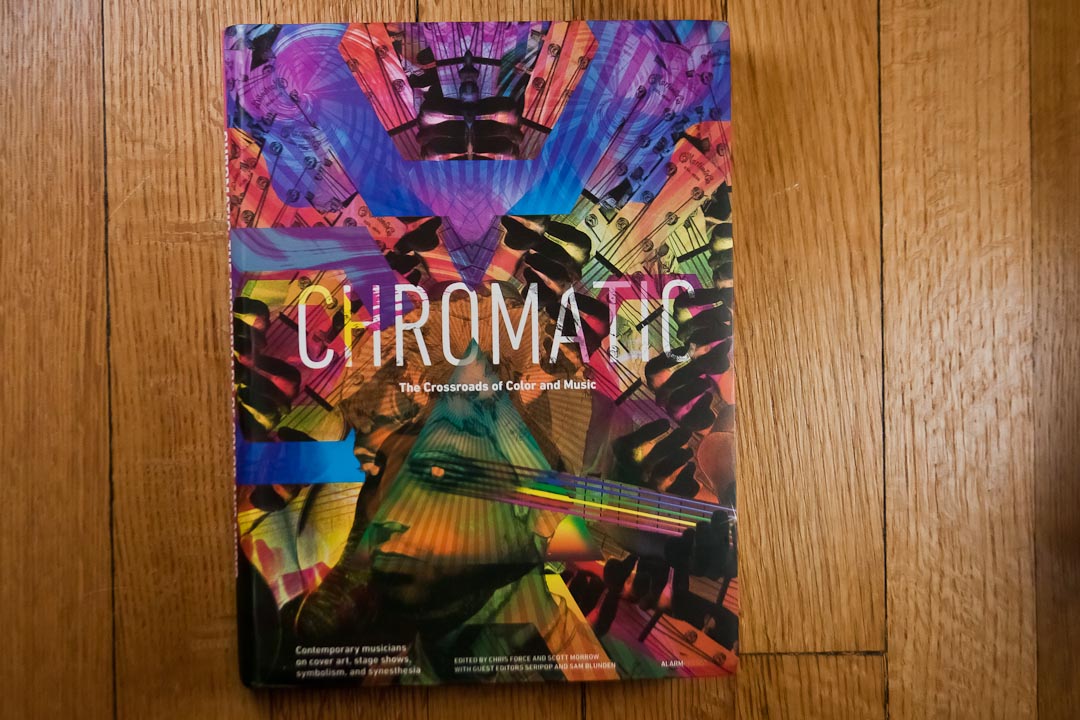
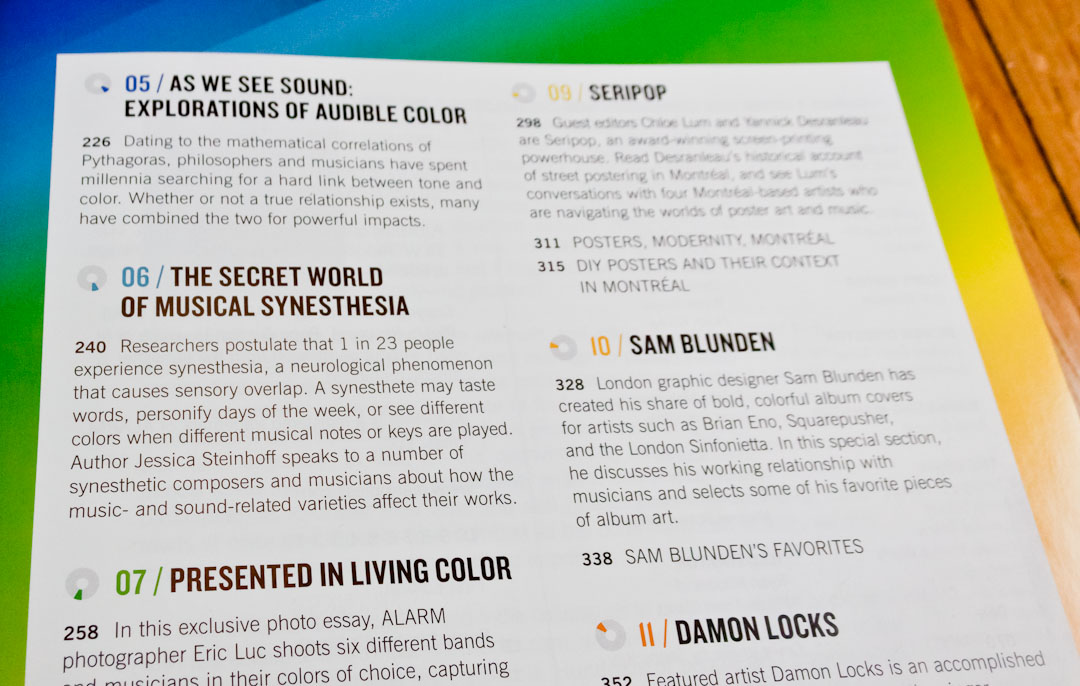
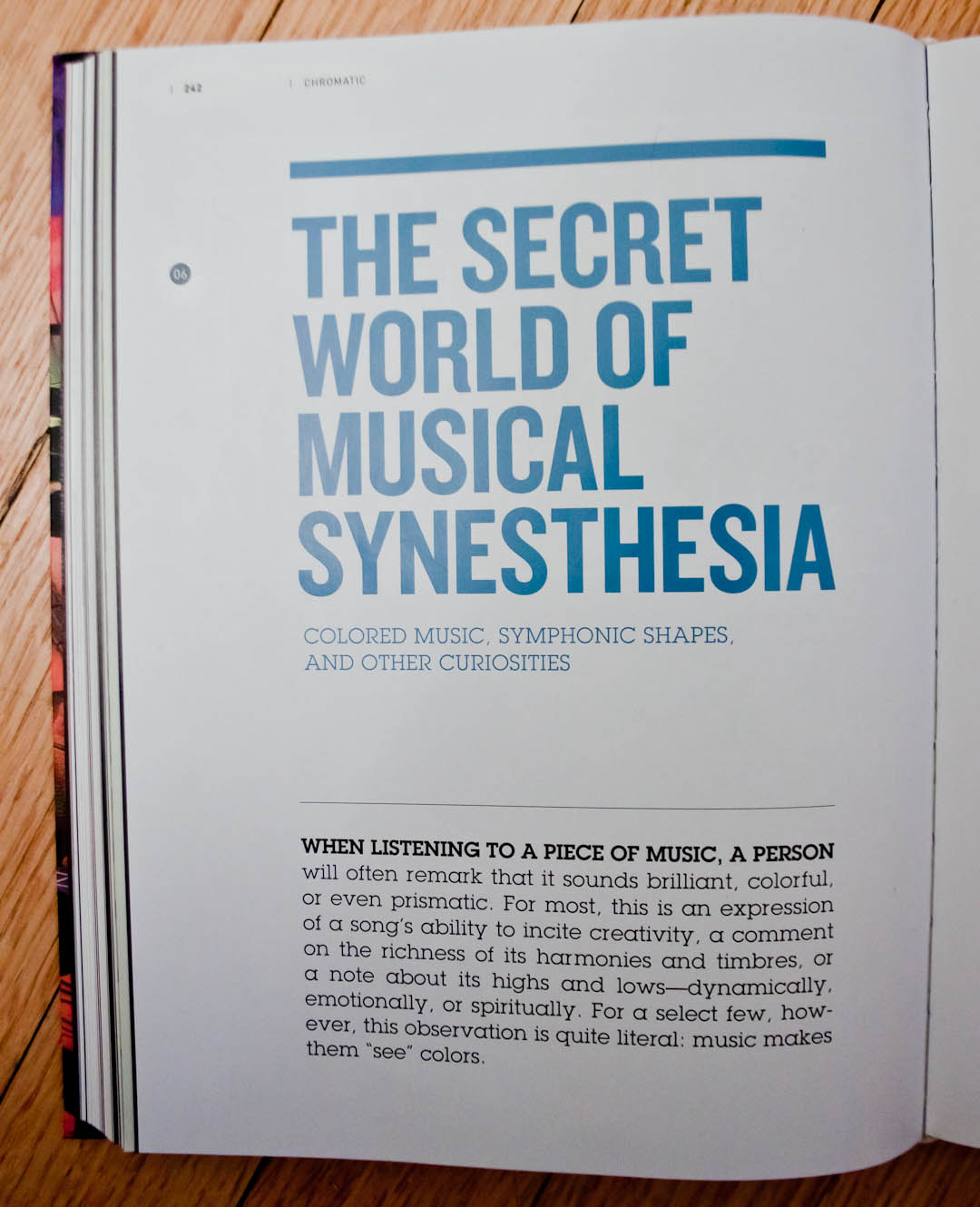
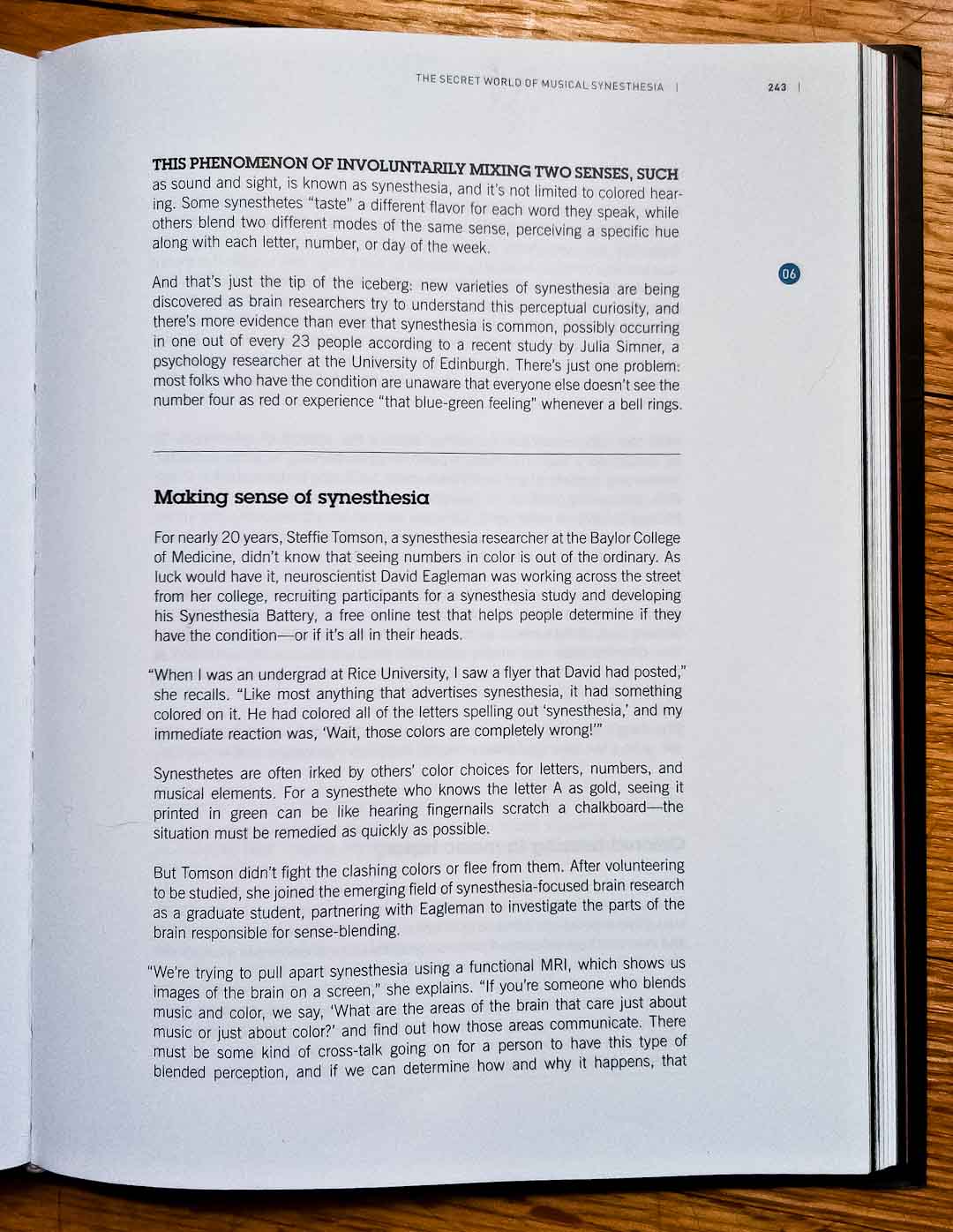
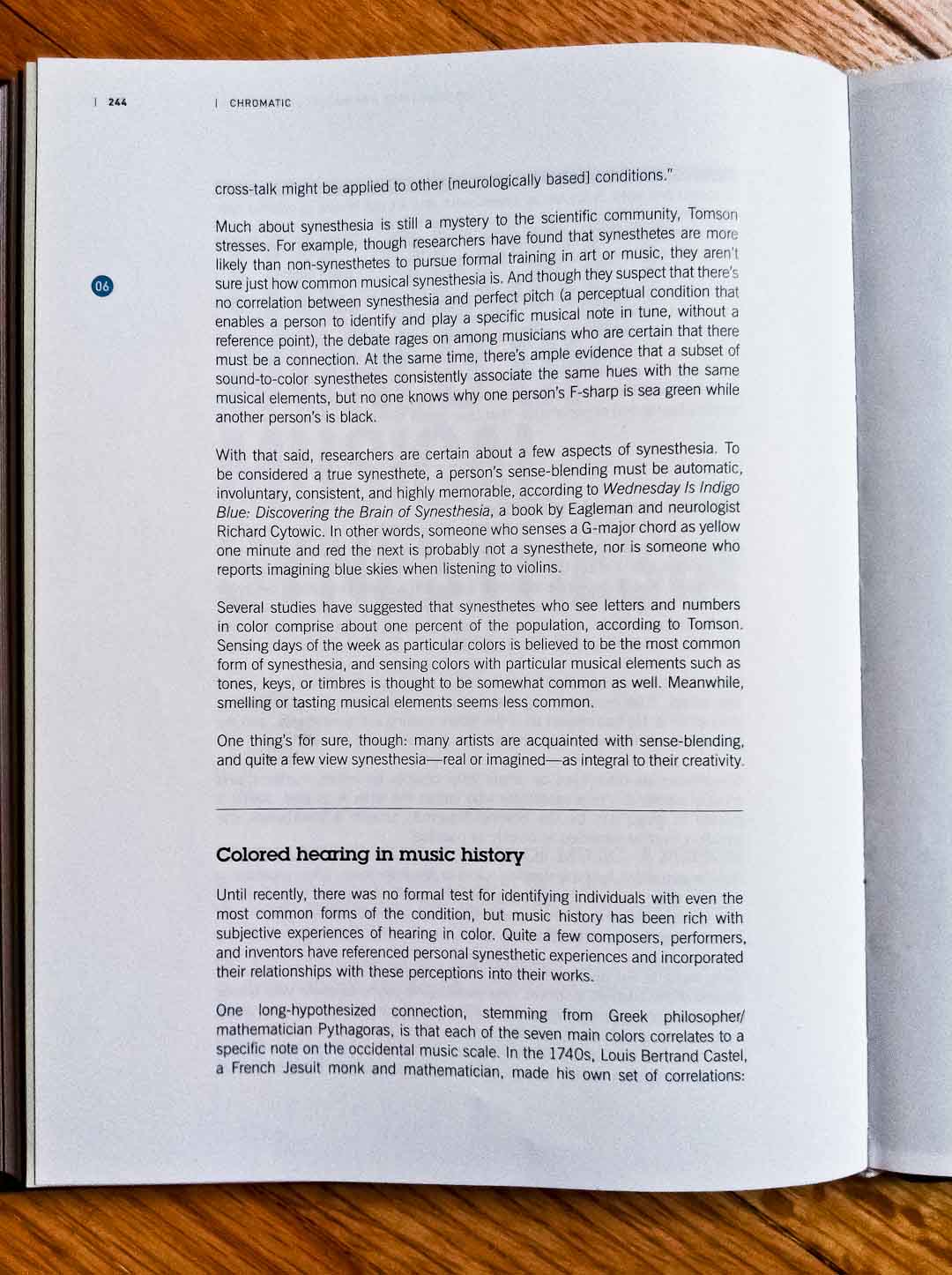
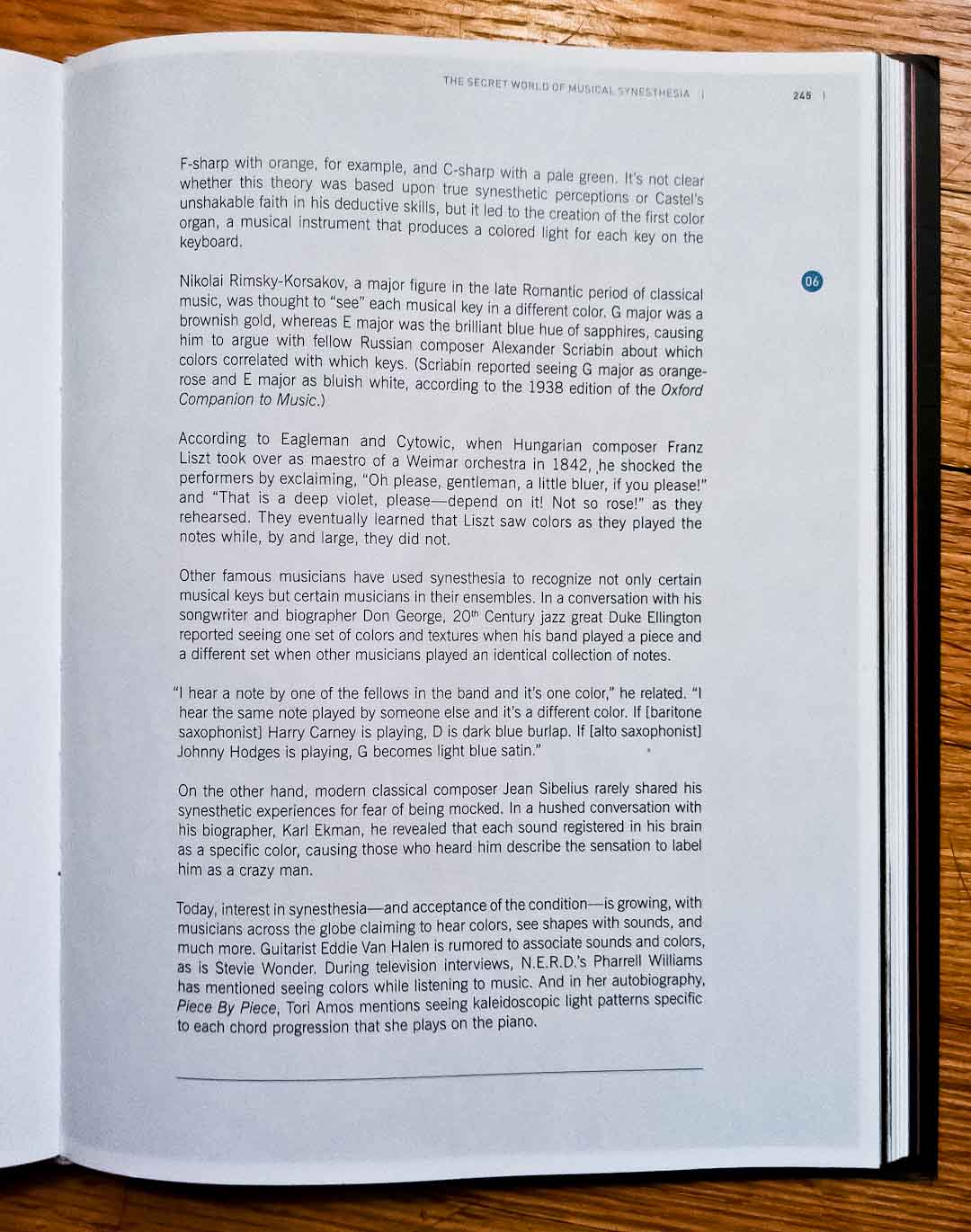
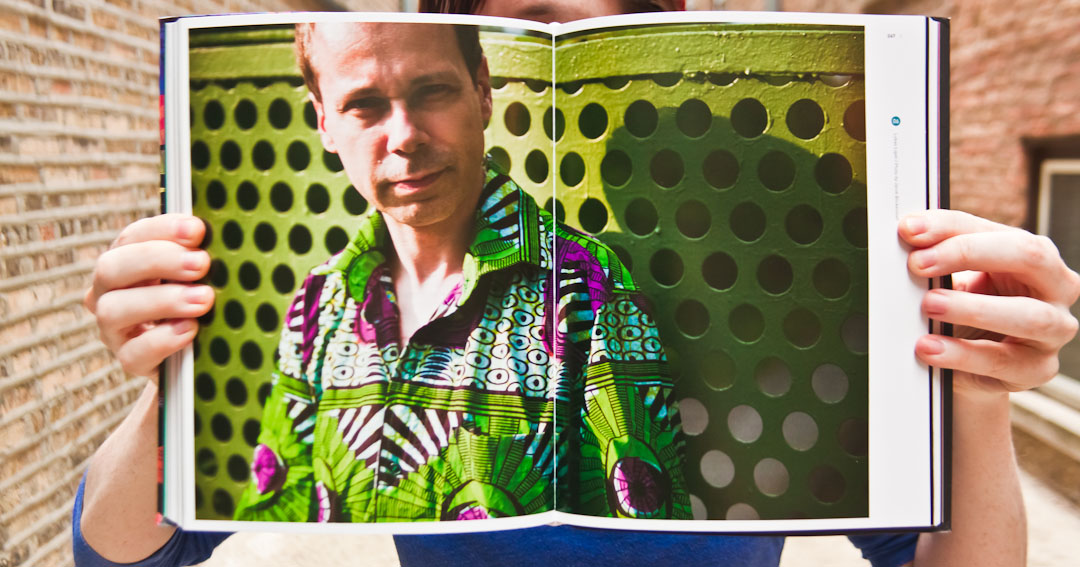

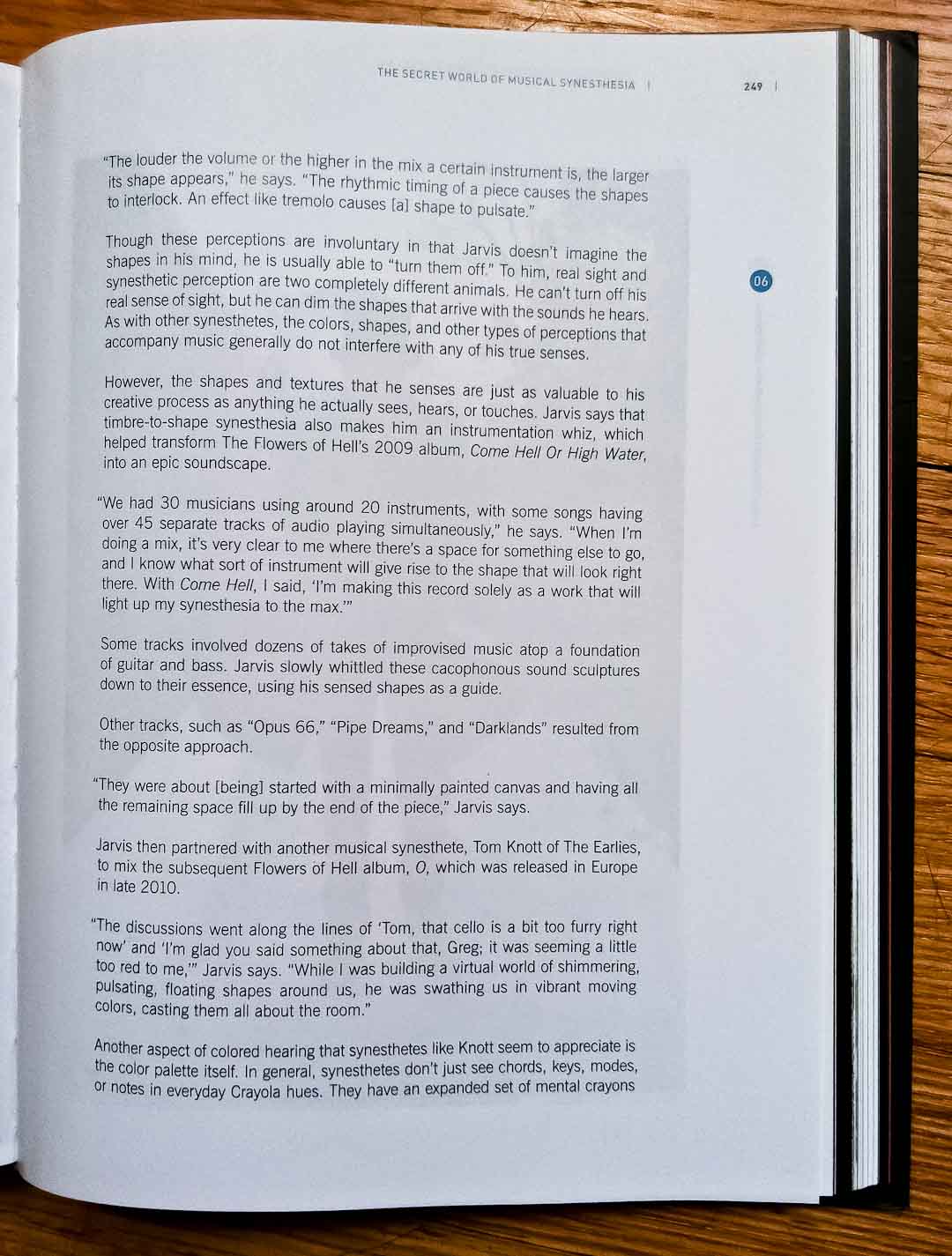

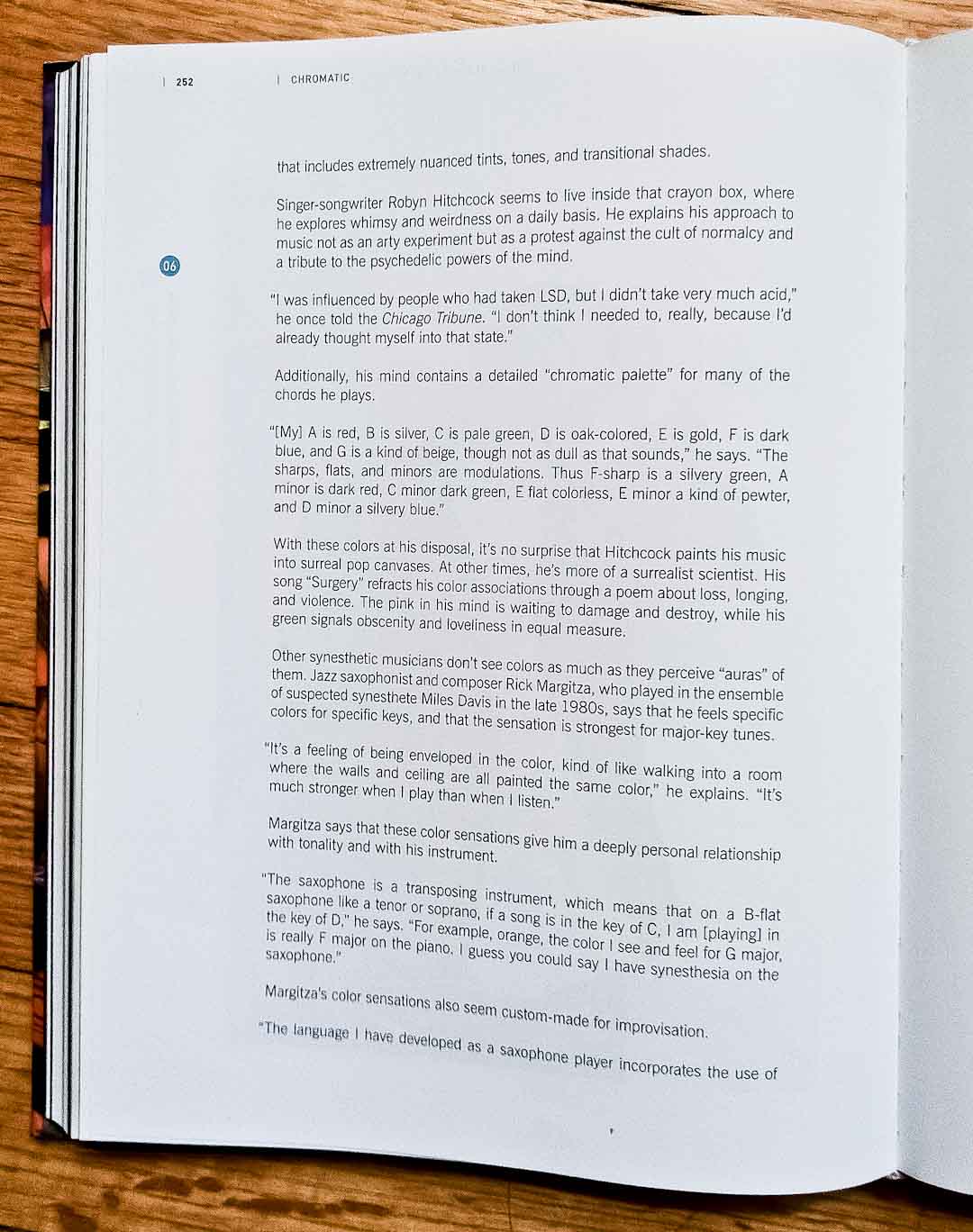
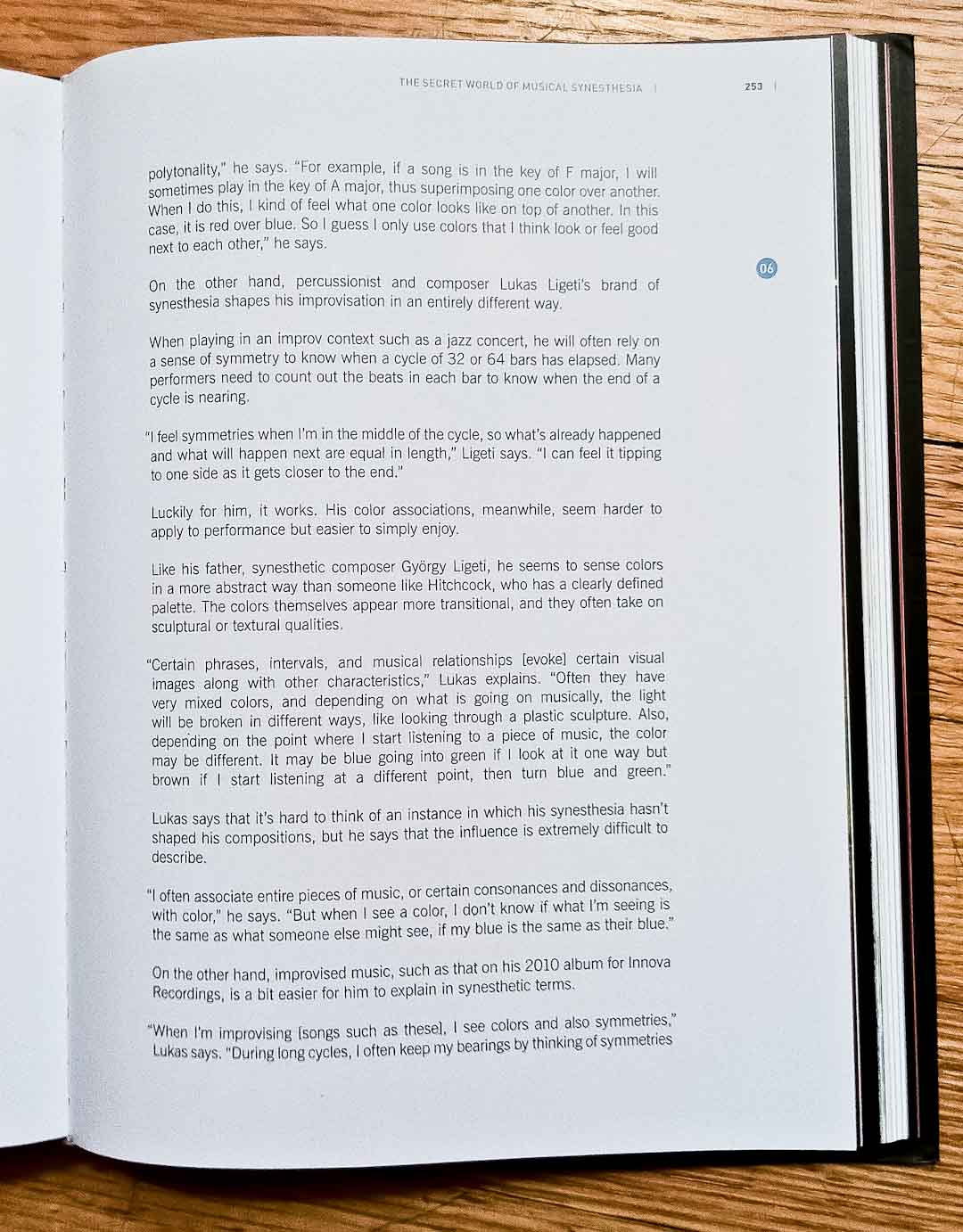
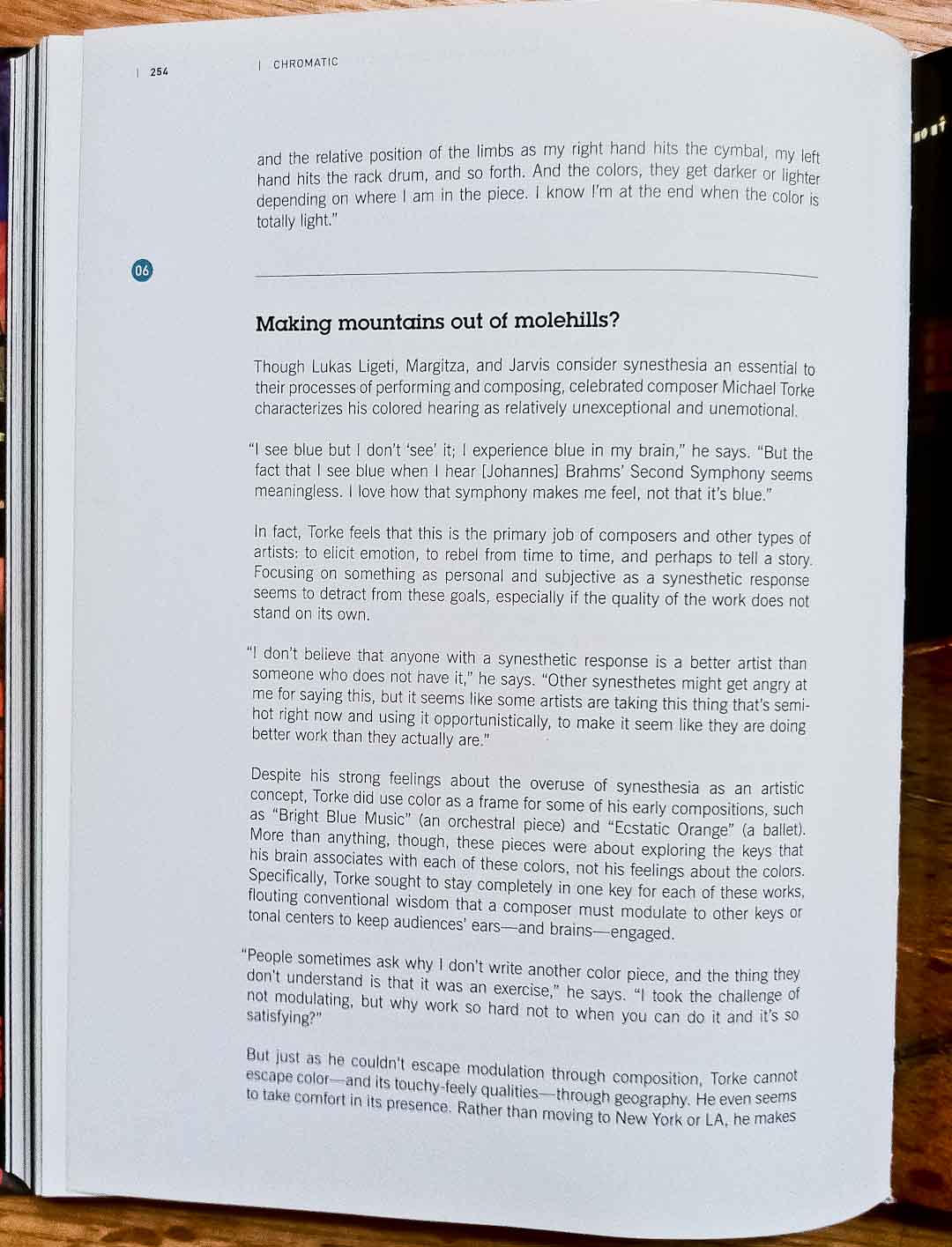
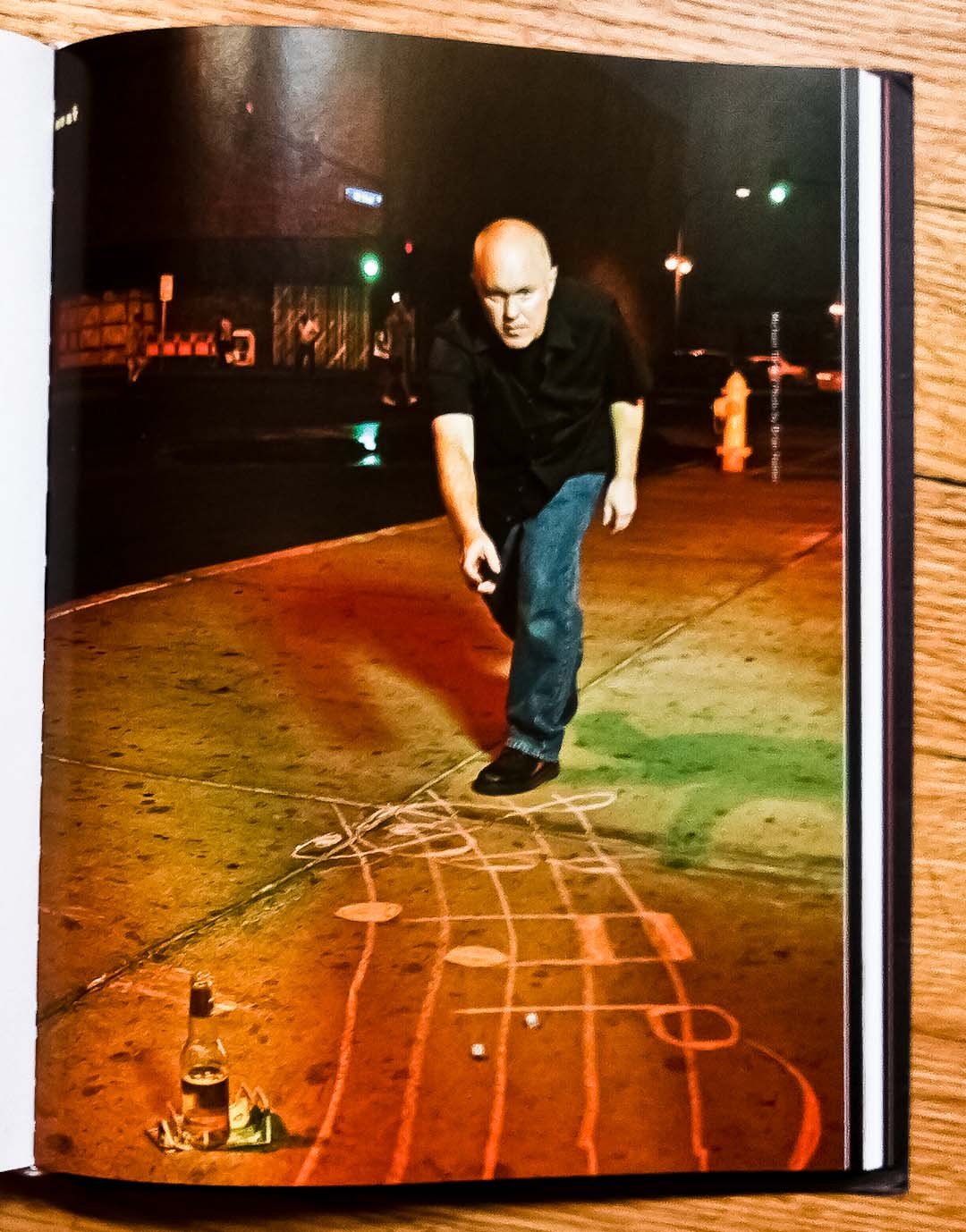

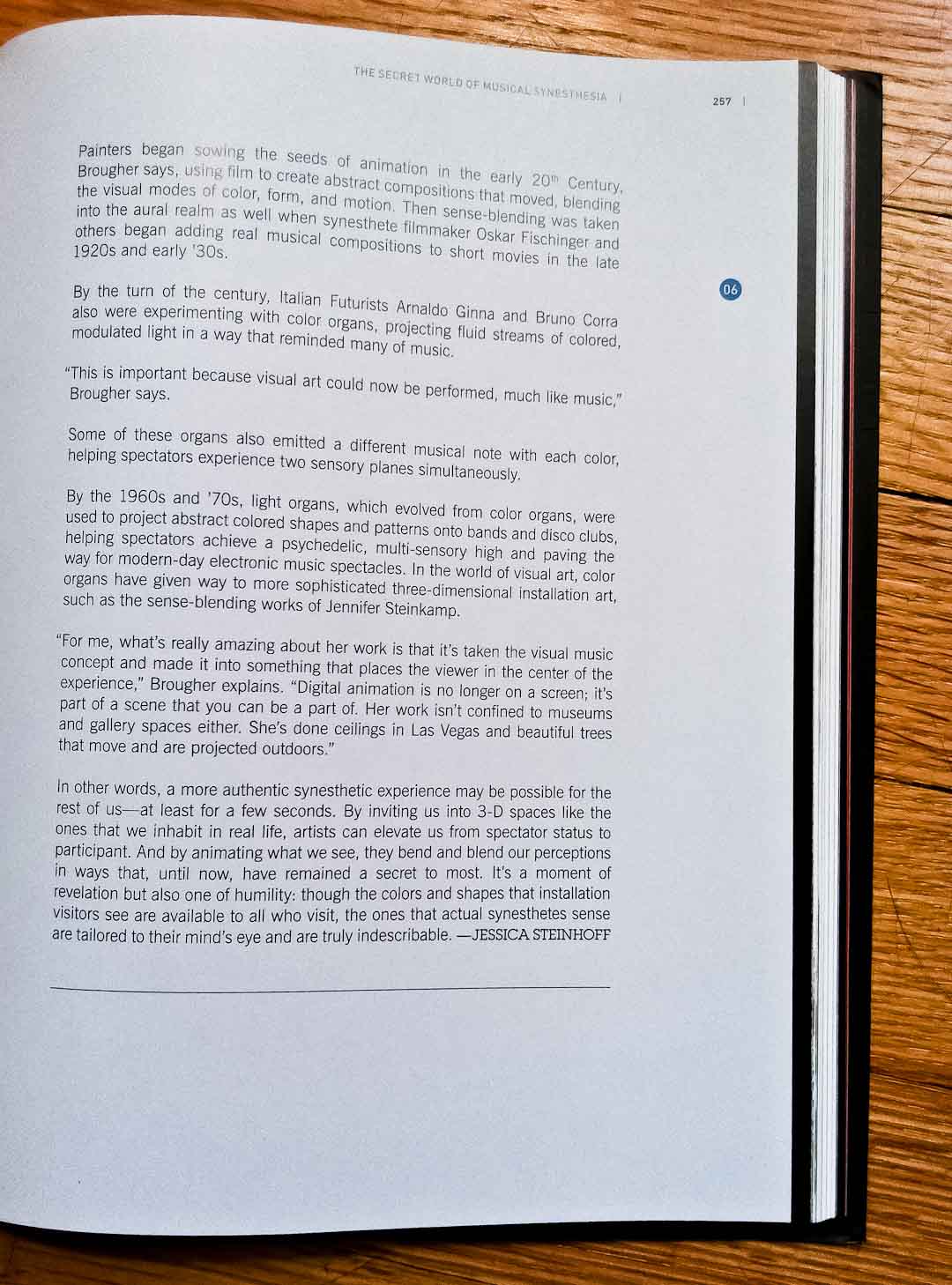

















In October 1992, nearly 1,000 music fans were arrested at a rave in Milwaukee’s Third Ward, sparking a controversy about electronic dance music and its purported influence on young people. In those days, DJs spun records imported from Europe as crowds in warehouses danced until sunrise, glow sticks raised.
After the raid, promotional word about raves spread quietly. Flyers led to a hotline number, then a recorded message, then a secret meeting spot, where you’d get a map to a far-flung barn or campsite. The stealth gave the movement a thrilling quality. But as the media hyped the dangers — designer drugs and fire hazards — musical trends changed, sending EDM deep into the underground.
Twenty years later, you can still attend a “rave” in Wisconsin, but it will be easy to find. A promoter will tweet about it, and it will take place at a public venue like the Alliant Energy Center, where on April 13, the electronic artist Bassnectar will crank out party bangers and inventive remixes of tunes by dance-pop darling Ellie Goulding and gypsy punks Gogol Bordello.
Many of the genre’s visual elements are the same as they were in the 1990s, but they’re bigger and brighter, with laser lights, fog and projected images that make mouths gape as thousands of bodies writhe to the rhythms of dubstep, electro house and other varieties of EDM. If you go to the Bassnectar show, look for a crowd writhing ecstatically in a stew of bleeps and bloops, waving their hands amid a miasma of confetti.
Dance till dawn
EDM’s popularity is booming. After performing mash-ups at UW-Madison’s student union five years ago, Girl Talk now fills the Alliant Energy Center’s 6,000-capacity Exhibition Hall. Bassnectar will likely do the same. He played the tiny King Club in 2007 and the Majestic Theatre in 2009.
Some fans who’ve experienced both rave scenes swear they’re similar. Matt Fanale, a local music fan who DJs under the name Eurotic, says a new generation of concertgoers wants to dress in neon and dance till dawn. To him, this is evidence that music trends come in 20-year cycles, and that the motivation to party is the same as it ever was.
“At rock shows, you’re singing and screaming along, but you’re not necessarily dancing,” he says. “With a DJ, you don’t have to watch what’s onstage. You can pay more attention to the other people who are there and feel a real connection to them for a few hours.”
Fanale suspects that the sluggish economy has fueled attendance at live electronic shows. “With the world as depressing as it has been lately, people want to lose themselves with thousands of others. It’s more fun to be happy than angry,” he says.
The paradoxically isolating nature of social media also plays a role, according to DJ Nick Nice, who helped launch the Midwest rave scene in the early 1990s after spinning records at Queen, a Paris club where David Guetta curated the music. “Facebook is such a solitary experience. It’s basic human nature to want to be social, and listening to music with thousands of other people reminds you that you’re not alone, even when the world seems to be falling apart,” he says.
Though these concerts can draw huge crowds and kindle a sense of connection, they can also create rifts. Madison resident Vinnie Toma loves to DJ. He’s built a career around it since 1998. But when he thinks about nuevo-raves, his heart sinks. Though many who attend these shows crave connection, this quest, for some, spirals into escapism.
“In this country, during times of economic downturn, you see the younger generation turn to music that’s a little less thoughtful,” he says. “Kids who are in college right now, or even several years out, there aren’t as many opportunities, and they’ve racked up tons of school debt. It can fuel a lifestyle that’s all about partying and pushing [difficult] emotions away.”
Local DJ Wyatt Agard says these big shows sometimes don’t feel like raves at all. In the early days, raves revolved around ideals like unity and respect. Partygoers hoped to find themselves as they swam through rooms of trance, house and techno — or at least that’s how they remember it.
“A lot of the [current] shows feel like concerts, not parties,” he says. “At raves, not everyone faced forward. There was this cyclical feeling as people moved around the room. Many of the shows now, people face forward, toward a stage, and stay put for hours.”
In other words, people tend to surround themselves with friends rather than explore. That can lend a rock vibe to events, especially at shows that incorporate rock sounds. “The Rusko show at the Orpheum [on Feb. 25] was a lot like a rock concert,” Agard says. “People were moving on beat but not dancing, and if you examine the music theory behind it, dubstep looks a lot like rock, except with electronic instruments.”
EDM goes mainstream
Despite EDM’s popularity, it didn’t gain much mainstream acceptance in the 1990s. Its sounds filtered into the public consciousness from underground. Nowadays, though, its key elements — synths, samples, sequencers — drive songs by Top 40 artists like Lady Gaga, Rihanna and Ke$ha, as Jay-Z raps atop Daft Punk tracks.
Daft Punk’s influence can’t be understated. The French duo, whose songs include “One More Time” and “Harder, Better, Faster, Stronger,” have transformed disco beats into music that sounds thoroughly modern, and their music can be found in the soundtrack to Tron: Legacy, videogames like Just Dance 3 and nearly every corner of the web. The group played one of their first live performances at a Wisconsin rave in 1994, notes Chris Vrakas, a Milwaukee-based DJ and event coordinator for Chicago-based concert promoter React Presents.
Daft Punk also proved that live EDM could be more than a DJ spinning records or tickling a computer keyboard. The group donned space-ready helmets on their 1997 tour, which spurred other EDM artists to bust out the theatrics. Glitch-hop act Pretty Lights crafts visual spectacles incorporating colorful lights and 3-D images, and Deadmau5 has designed his own whimsical headgear with the help of Jim Henson’s Creature Shop.
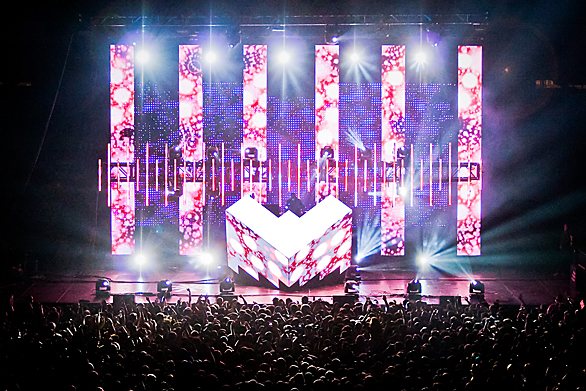
Ryan Parks, a local EDM fan who hosts WORT’s “Something Wonderful” on Monday Nights, says Deadmau5’s live show is particularly buzzworthy.
“He blew me away, and I’ve seen hundreds of concerts: Paul Oakenfold, the Chemical Brothers, you name it,” Parks says. “It was a multi-sensory experience, where the visual aspect worked in tandem with the sound. The cube he was sitting in would broadcast these 3-D images on the walls, more and more of them as the night went on. Pretty soon, they were popping up everywhere and reflecting off his mask as they pulsed along with the beat.”
These abstract effects attract various kinds of fans, from music-loving Gen X-ers like Parks to kids barely old enough to drive. The under-30 set tends to dominate, though. According to UW-Madison seniors Azaria Posik and TJ Matzen, who book, blog and promote for Wisconsin Union Directorate’s music committee, EDM’s popularity among college students relates to the scene’s inclusiveness. There’s no need to memorize lyrics or wow others with band trivia, which makes it easy to invite large groups of friends to the show.
“My girlfriend and her roommate, if they hear that an act is good to dance to, they’ll go to the show in a big group,” Matzen says. “The electronic scene is more welcoming and more about letting loose than the indie rock scene.”
Adds Posik: “Word of mouth can be really powerful for these shows. People text their friends, who text their friends, and then party buses are showing up at the Bassnectar show.”
Recession-friendly jams
DJ and promoter Agard says live EDM’s popularity stems from booking decisions clubs made to weather the recession. “The downfall of the economy made it expensive to book bands, so clubs started booking more DJs because DJs have a higher draw per dollar spent,” he says.
Some club owners got acquainted with EDM artists at festivals like Bonnaroo and 10,000 Lakes. “Artists like Bassnectar performed at these festivals back in 2005 or 2006, but they weren’t headlining then,” Agard explains. “They were playing the afterparties, which is how a lot of promoters got hooked on them — and trends like dubstep.”
Take Majestic Theatre co-owner Matt Gerding. Despite being a rock enthusiast, he couldn’t help but notice that Deadmau5 and Bassnectar were climbing the ranks at Lollapalooza.
Now Gerding books many of the area’s big EDM shows, including 18-and-up performances at the Orpheum and the Alliant. Riding the EDM wave has been exciting, he says, because it’s uncharted territory for the Majestic team. Booking the shows has meant making some potentially costly decisions about bumping acts like Deadmau5 and Bassnectar to the Alliant.
“Moving a show to a larger venue, that’s a decision made mostly by the artist’s agent, manager or record label, when tickets are moving at a speedy clip,” he says.
The risk has paid off, and several EDM artists now visit Madison twice a year rather than once. This is good news for venue owners, but it can mean slow nights for local performers who draw some of the same crowd.
Still, fans miss out when they trade local events for the lasers and costumes of touring acts, according to local DJ Josh Landowski, a.k.a. Landology. It is, he notes, impossible for an artist to tailor a set to a crowd of thousands. “At somewhere like the Alliant, you know your set ahead of time,” he says. “You’re feeding off the crowd’s energy, but it’s more about you than them. You almost have to be over-the-top, so people will pay to see you again.”
So fans seeking to lose themselves in a sea of revelers can go to one of the giant arena dance parties. But they should hit up a local event for some personal attention. If you’re a DJ playing a club or restaurant around town, says Landowski, “you focus on even the smallest reactions from the crowd.”
Tuva is a Siberian republic surrounded by two majestic mountain ranges and peppered with tiny deserts, lush valleys, and more than 9,000 rivers. Population-wise, it’s about the size of Iceland and shares a similar history of being isolated from much of the world for thousands of years due to its location and chilly temperatures. Music-wise, it’s one of the most amazing places you’re likely to discover.
Much like the home of Björk and Sigur Rós, Tuva is immersed in a musical tradition that’s deeper than its permafrost. This tradition revolves around throat singing, an art form in which multiple voices seem to spring from one vocalist thanks to the magic of harmonics and overtones.
Scientifically speaking, a singer can amplify different parts of a sound wave by changing the shape of various cavities of the mouth, voice box, and throat, allowing sounds that are subdued in most vocal performances to take center-stage. The result is a sound that’s been described as a “one-man quartet” and even a “bullfrog swallowing a whistle,” as the 1999 documentary film Genghis Blues puts it.
The Alash ensemble, a quartet composed of Bady-Dorzhu Ondar, Ayan-ool Sam, Ayan Shirizhik, and Nachyn Choodu — four twenty-somethings trained in this ancient art by their parents, grandparents, and a healthy dose of intuition — serves as Tuva’s musical ambassador to the United States.
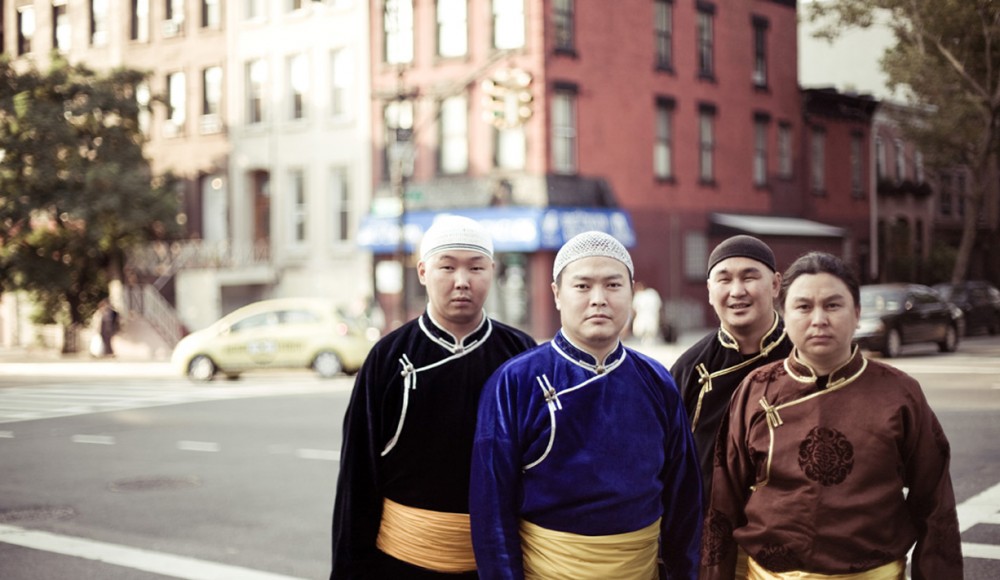
“Things like Jimi Hendrix and the [Sun Ra] Arkestra are slowly but surely having an effect on our music; it’s not so much about directly mixing these artists’ sounds with throat singing but how it affects the way their music feels.”
Over the past three years, the group has performed with the Sun Ra Arkestra, recorded a Christmas album (Jingle All The Way) with Béla Fleck and the Flecktones, and introduced numerous students to a style of music that sounds like a mix between Tom Waits and a flock of swallows.
The band’s flagship song, “Alash,” with its bouncy melody, could be a tune from the Appalachian Mountains or the hills of Ireland. At other times, the group’s sound is more abstract, reminiscent of distant trains, or the yip-yipping martians from Sesame Street.
The music inspires comparisons to nature and the great beyond. Alash is named after one of the most majestic rivers in Tuva, symbolizing the band’s connection to the water from which its ancestors drank thousands of years ago. And just like the movement of water from clouds to streams to lips and back again, Tuvan songs pass from the spirits of nature to the souls of humans, released back into nature via the lips of throat singers.
Though many of Alash’s melodies have cycled through Tuva for centuries, the way the group presents them to the cosmos is very new.
“Things like Jimi Hendrix and the [Sun Ra] Arkestra are slowly but surely having an effect on our music; it’s not so much about directly mixing these artists’ sounds with throat singing, but how it affects the way their music feels,” the band says, via manager and translator Sean Quirk. “We have a new song about reindeer herding. Even though the piece focuses on this practice that’s very much about Tuva, you can sense these other influences if you’re listening closely.”
This is a huge breakthrough for a musical tradition that still considers stringed and woodwind instruments new additions. These instruments include the igil, a two-stringed instrument that’s played like a cello; the doshpuluur, a three-stringed instrument that’s plucked or strummed like a banjo; the byzaanchy, which has four strings that represent the udders of a cow and are “milked” to create a sound; the chadagan, which resembles a zither or a koto; a jaw harp known as a xomus; the murgu and limpi, two types of flutes; and a large drum called a kengirge, which often comes with a set of reindeer bells.
Alash uses all of these instruments and a few others to create a sound that’s lush and layered, with rhythms that duel one moment and collaborate the next. And unlike most bands, Alash will even teach you how to play the instruments — as well as how to build a yurt and cook up some Tuvan snacks — at its concerts, if you have the time and the money. It’s all part of an effort to welcome people from other cultures — especially Americans — into the fold.
“The touring is all about creating a good impression of Tuva and conveying something about the lives of people who live there,” Quirk says, “and maybe attracting a few visitors. Tuva loves guests.”
It’s also a way of bringing bits of the West back to Tuva, which still shows relatively few signs of capitalism. Though many Tuvans descended from nomadic tribes, they are not immune to pangs of homesickness.
When traveling the roads of Texas and Oklahoma, the lonesome cowboy is one American figure Alash can relate to, but not for his cigarettes. It’s because he also feels incomplete without his trusty steed. To keep spirits high, the band adopted a wrangler look — ten-gallon hats and all — when traveling through Texas, stopping in Fort Worth to ride a mechanical bull and visit some friends with a horse ranch.
“Like many people from Tuva, they feel most at home when riding their horses,” Quirk says.
Composer John Cage, the man responsible for the world’s first song that consisted entirely of a man sitting idly in front of a piano, adored randomness in its many forms. So did choreographer Merce Cunningham, one of Cage’s most important collaborators and his longtime boyfriend. Though both men were pioneers of avant-garde art and teachers at the super-experimental Black Mountain College (also the home of artists Josef and Anni Albers, Willem De Kooning, and Robert Motherwell), neither focused on visual art. It’s their shared love of randomness that unites the visual works the Madison Museum Of Contemporary Art has assembled in Cage And Cunningham: Chance, Time, And Concept In The Visual Arts, on display through May 9.
A lack of structure and formality becomes the show’s common thread, forging connections among pieces from the Bauhaus school, the conceptual art movement, and the ’60s “happenings” of the New York City counterculture. It’s not always clear how exactly the works should be associated with Cage or Cunningham (with some exceptions); perhaps the show’s curator wanted it that way.
Sol LeWitt’s 1991 etching “Vertical Not Straight Lines Not Touching On Color” consists—surprise, surprise—of a smattering of white vertical lines, some more squiggly than straight, on a black rectangle of background. Each line is pencil-thin and hairlike, and several of them veer so close to one another that they appear to touch, despite what the museum’s notes about the piece say. As the title suggests, this piece is more about absence than presence. LeWitt’s idea becomes more important than the execution of his idea, illustrating what conceptual art is about.

Cage And Cunninghan also offers a roadmap for understanding how things such as noise and found sounds have become the musical staples they are today. Two pieces by George Maciunas show how the multimedia Fluxus movement of the ’60s, a precursor to the modern noise-music craze, among other things, used games and chance to create a new set of rules for art and music. “Single Card Flux Deck” displays a deck of 52 cards, all of which are spades. Three sets of four tens are turned up, as if to illustrate a winning hand in a game from another culture—or another dimension. It’s as simple as it is mind-boggling.
“Fluxshop Sheet,” on the other hand, is both a game and an advertisement for one. A poster made of black ink on old, yellowing paper that gives it an old-timey feel, like a wanted poster in a saloon, it contains two blocks of text, one horizontal and the other vertical, that spell out a manifesto (or something like one) for such Fluxus artists as Yoko Ono, Ay-O and George Brecht. It spouts activist terms like “nonprofit” and “nonparasitic” while an old-timey cartoon character entices viewers with “games, gags, jokes, kits.” Sixteen faces at the bottom of the piece hold letters on their tongues (or perhaps their chins) that spell “flux orchestra.” It’s yet another example of how Cage and his followers blurred the lines that separate literature, visual art, and music.
“Weather-ed II,” a color photoetching by Cage himself, ventures into the territory of meteorology. With abstract lines rendered in grays, blues and purples, he doesn’t examine the raindrops and lightning but the randomness of weather patterns, from the way they take shape to the way we interpret them. These lines are framed by two boxes that function as windows for watching one storm happen and another one brew. At the same time, they’re a bit like music players as well, with Cage’s lines forming shapes that look suspiciously similar to sound waves. Perhaps this is a chance resemblance, but if so, it’s one he would probably have appreciated.
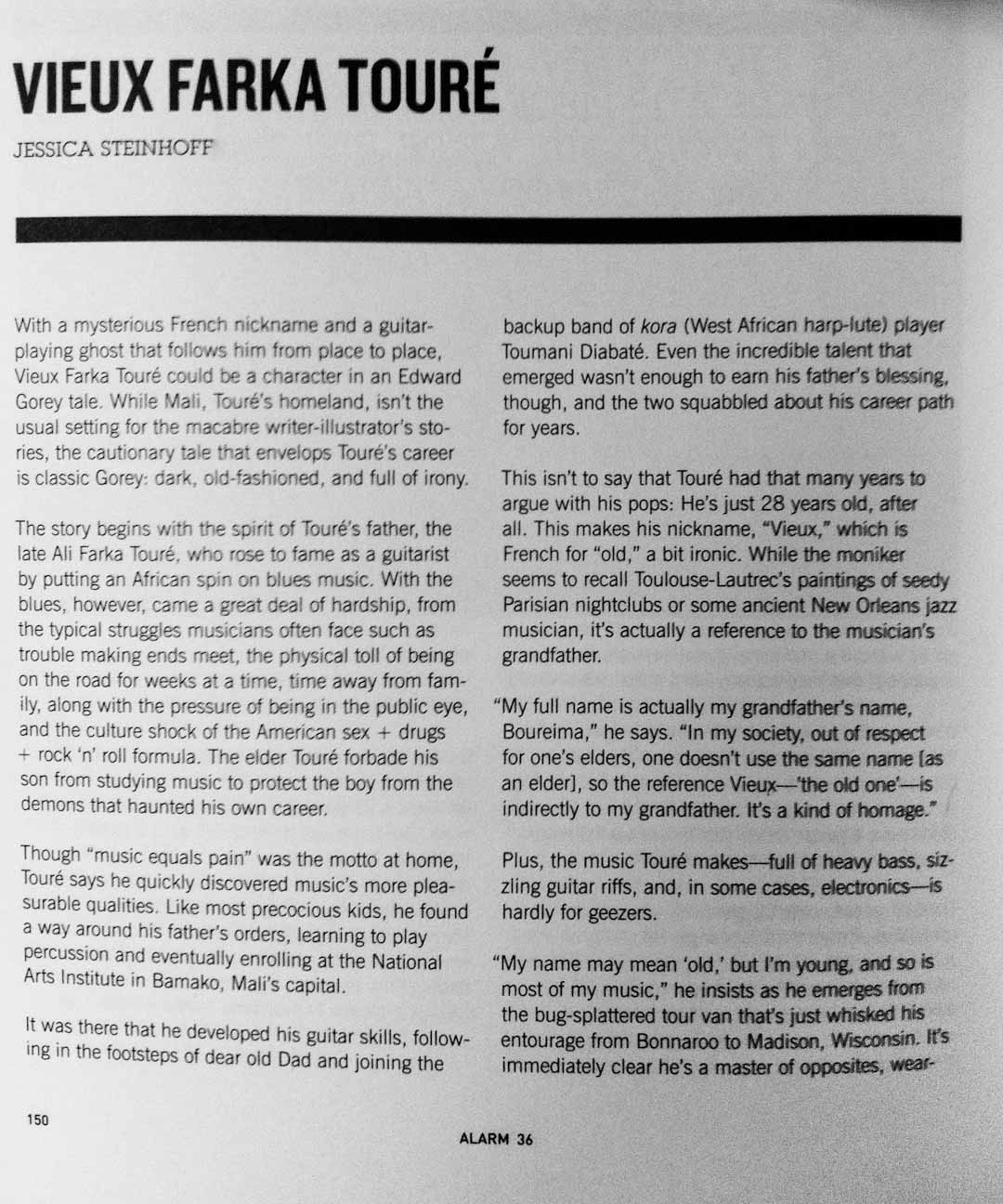
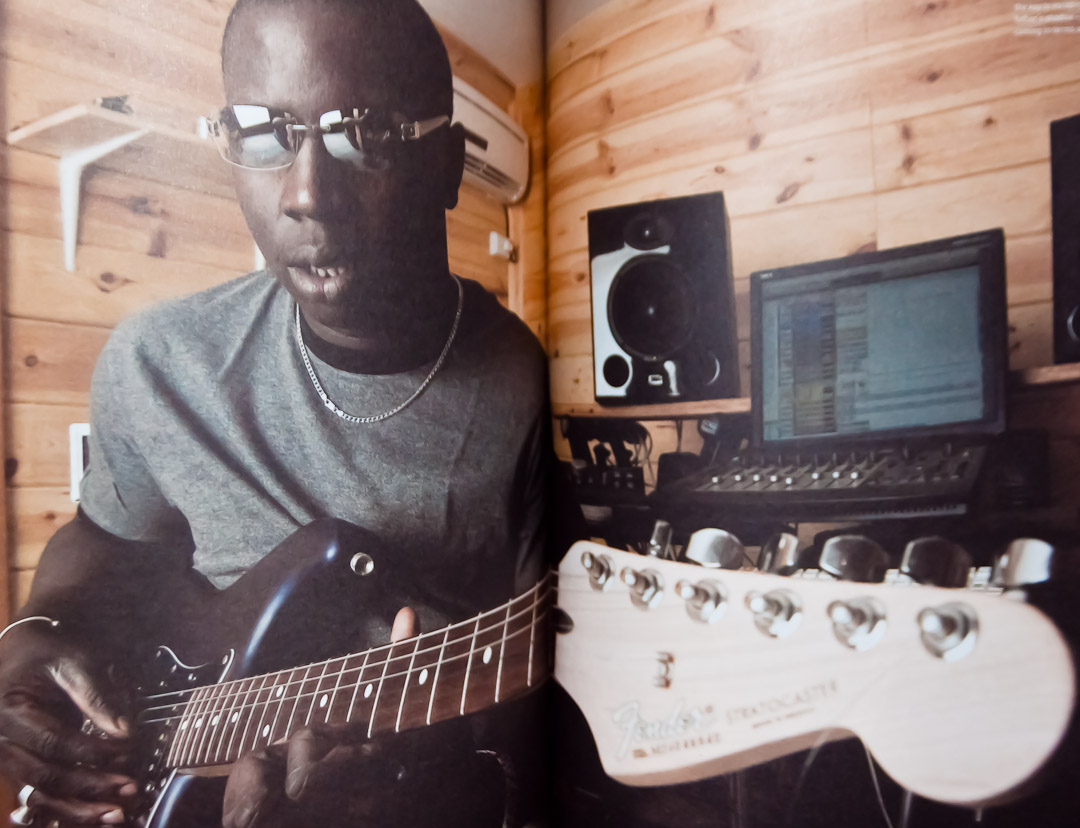
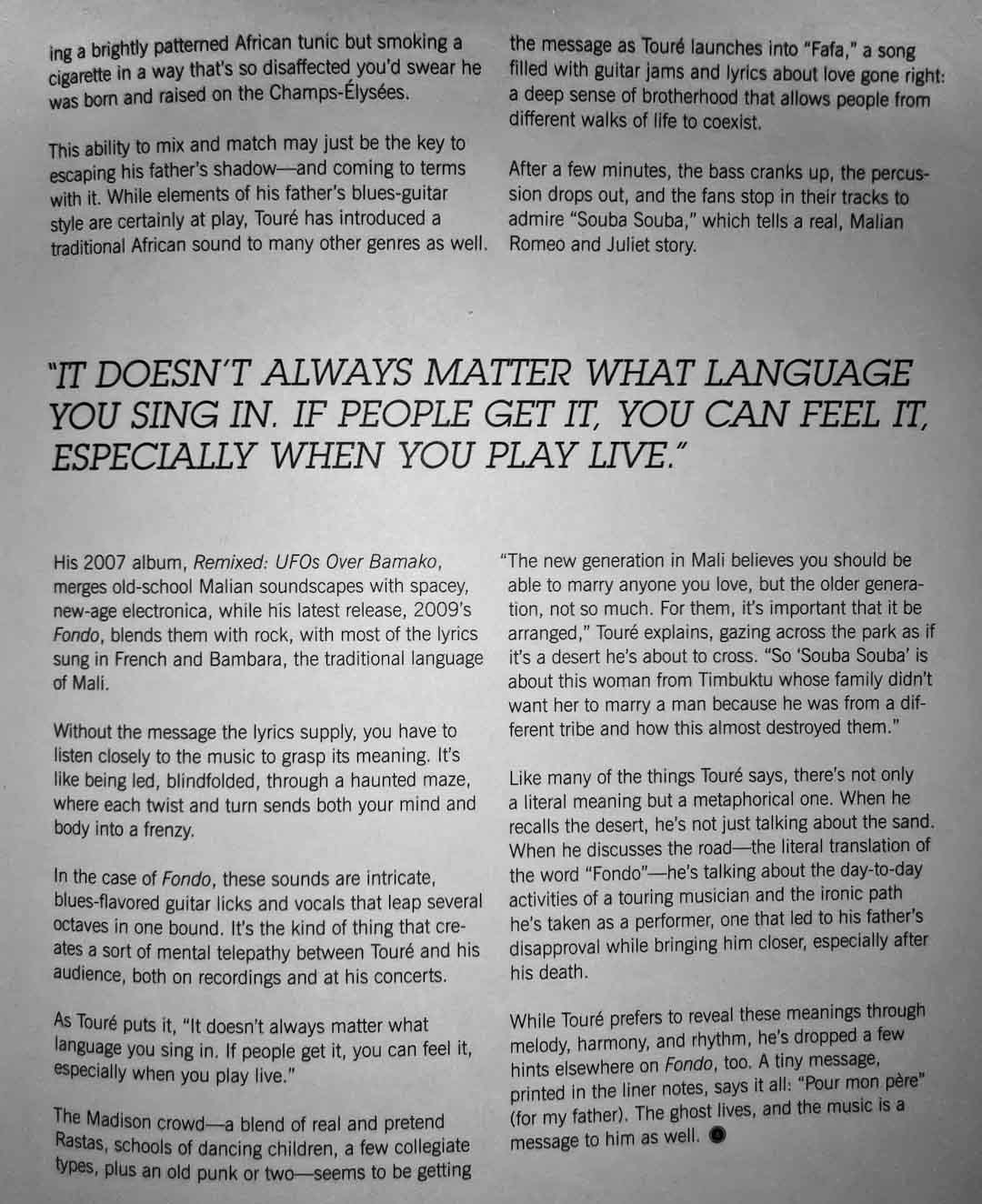
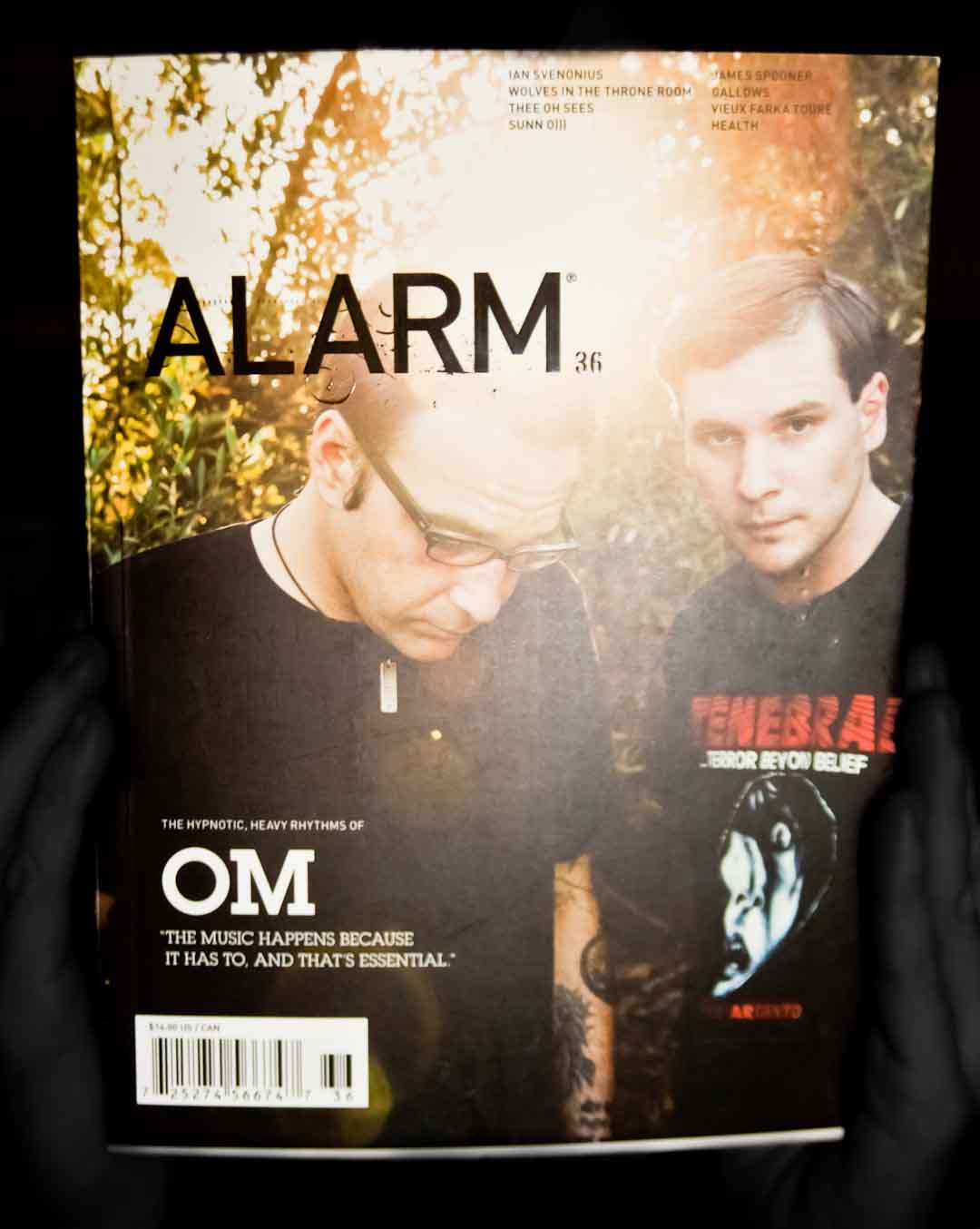
It was one of the coldest nights of winter 2009, but the Wisco was sweltering with rock ‘n’ roll. The Goodnight Loving were in from Milwaukee, Screamin’ Cyn Cyn & the Pons were in top form, and the Midwest Beat’s Matt Joyce did a scorching solo set. The only band I’d missed was the Hussy. I’d caught the tail end of their set on three different occasions and was hoping this night would be different.

Frustrated, I stomped down the steps, ready to kick the nearest snow bank. That’s when I saw it: a Hussy T-shirt, just my size, drenched in sweat. I almost needed an ice pick to remove it from the sidewalk, but after that, the shirt became my most treasured item of clothing. I wrote in it. I slept in it. I lent it to my friends. The shirt made people laugh, and it started conversations. It got me talking, too, no small feat for someone prone to shyness. Plus, it reminded me to catch the Hussy’s next show — and buy another one of their shirts.
For local musicians, merchandise works magic. Not only does it help fans find one another and show off their taste, it allows Madison bands to take their shows on the road. For groups like All Tiny Creatures and the Pons, merch has funded trips to South by Southwest. For others, it has funded recording time in Seattle and tours of Europe.
Kurt Baker, the Madison native who fronts the Portland, Maine, pop-punk band the Leftovers, says that merch — as it’s universally called — means food, fuel and other necessities to get from one town to the next.
“A lot of bands getting out on the road for the first few times don’t get a door deal or much money from the clubs they’re playing,” he explains. “This is especially true for unsigned bands and those on smaller indie labels. They depend on people buying their merch to pay for gas money, food and motel rooms.”
But that’s just the beginning. More and more bands, it seems, are financing their careers with merch rather than mp3s. Irving Azoff, the artist-management magnate who represents Jimmy Buffett and Neil Diamond, explained in a recent New Yorker article that merch sales and third-party sponsorship have virtually replaced record sales in the music industry’s moneymaking model.
This shift has benefited bands such as Massachusetts’ Dropkick Murphys, who reportedly make more from merchandise than recordings. Mike Krol, who drums for Whatfor and Time Since Western and until recently worked for the Madison-based design firm Planet Propaganda, says he’s figured out the secret. He did it by observing one of his best friends, the Murphys’ merch buyer.
“I hung out with him when the Murphys played the Majestic last year, and he literally set up a shopping mall for a merch table,” Krol says. “He does an amazing job with getting the most random merch items: golf balls, bottle openers, Trapper Keepers, key chains, beer koozies, baby bibs, grocery bags.”
Another Madison-bred band Krol sometimes drums for, Sleeping in the Aviary, have adopted an even wackier approach. They’ve been known to peddle clippings of their hair in Ziploc bags and thrift-store coffee mugs decorated with their faces. Krol’s favorite was a huge pair of pink, one-piece pajamas.
Other local groups are upping the ante for creativity and craziness. Masked surf-rockers Knuckel Drager have been making merch awesomeness for years. Darwin Sampson, owner of the Frequency and bassist for Helliphant and Ladybeard, says he’s proud to own one the band’s signature action figures — or fingers, as the case may be. “[It’s] the ‘El Diablo Action Figure,’ which is merely a plastic hand flipping the bird,” he says.
Then there’s the gumball dispenser Knuckel Drager’s Matt Villand unveiled at last month’s Melt-Banana show. “It gave out random objects like vampire teeth and plastic rings,” recalls Knuckel Drager bassist Bill Borowski, who helped open the show with his other band, United Sons of Toil.
More creations by Villand and his bandmates are available through the Black Cat Printing Company, which creates merch items like posters, T-shirts and, yes, gumball machines for other musicians.
Other designers from the area are also using band merch to show off their creative powers. Krol has made baseball jerseys for Icarus Himself, while artists from the recently shuttered art collective Firecracker Studios made hundreds of gig posters over the course of five years. In September, the Project Lodge even hosted an art show of posters custom-made for the Forward Music Festival, submitted by designers from here to Philadelphia.
While a designer can spruce up a band’s merch offerings, lots of bands without design pros are trying their hand at creating stuff, too.
For Shane O’Neill of the Pons, his electro-meets-comedy venture Shane Shane doubles as an outlet for his craft projects. He even runs an Etsy store when he’s not working on lyrics and dance moves.
At Shane Shane shows, O’Neill dresses up as a giant soft-serve cone, then heads to his merch table to distribute free, ice-cream-themed buttons and stickers. This gets people interested in buying his T-shirts, and it gets them talking about the show.
“I treat stickers, CDs, patches and buttons as promotional materials and only charge money for shirts,” he says. “It’s nice to poor people, and I’m hoping it provides free advertising.”
Even venues are getting involved. At the Frequency, a slew of gig posters, most for local bands, covers the stage room from floor to ceiling. Band stickers, ticket stubs and guitar picks adorn the bar.
Sampson says these decorations have provided an instant conversation piece for customers and have given his staff and bandmates a chance to reminisce. Plus, when bands play there, they have a way to leave their mark.
Near the Frequency’s jukebox and Arkanoid machine are glass cases filled with all sorts of kitschy oddities: a can of “meat” sold by the band Human Aftertaste, an autographed photo of Britney Spears a Frequency employee found during Hippie Christmas, a Mozart action figure and much more. These items pay tribute to Madison showgoers’ merch-buying obsessions while mocking them with a smile and a wink.
For fans, there’s fun to be had in building their own shrines of merch. The process breaks down the wall between performer and audience, especially when a merch-table visit leads to a conversation.
Think of a purchase as a way of thanking a band for rocking, says Jake Shut of the local Crustacean music label.
“When a band that was not on my radar leaves my jaw on the ground with an incredible set, I feel the need to buy some merch from them out of gratitude,” he explains. “And when a band like this can give me an experience that’s a vivid reminder of why I’m so obsessed with music, they deserve some more of my money, sort of akin to getting exceptional service at a restaurant and leaving a fatter tip as a result.”
On the flip side, merch tables are a place for musicians to thank fans for coming out to the show. For Jess Northup of Gold and Shooter Grey Suede, two Chicago bands that play Madison regularly, merch tables have taken the form of a bake sale, with brownies and coffee from bandmate Mike McSherry’s bean-roasting business.
There’s an added benefit as well: The more enticing the merch table, the less isolated the band feels, especially if it’s far from home.
“On tour, Gold will put anything on the merch table that seems remotely interesting, like sunglasses from gas stations,” he says. “We also have a fake fur we use as a backdrop. It encourages people to come over and hang out. Touring gets lonely, after all.”
While the fur and snacks give Gold’s table a twisted Cub Scout vibe, Shane O’Neill says his merch peddling is more like going on a date. “You want to treat someone buying your merch as you would someone buying you a drink,” he says. “They’re also buying your time, so be nice to them and make small talk.”
The Leftovers’ Kurt Baker even suggests that bands bring cameras to their merch tables to keep the conversation going after the show’s over.
“Take a picture with your new fans buying your stuff, then post it online and make them feel special,” he says. “It’s all about connecting with people at the shows and being on a personal level with the audience.”
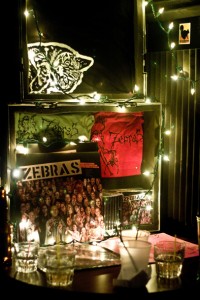
Dressing up the merch is key. Local bands like Zebras and Underculture have used Christmas lights to add flash to their T-shirts and recordings, even in the middle of summer.
Underculture drummer/vocalist Nate Onsrud says the lights aren’t about holiday cheer. They’re about drawing people’s eyes across a crowded room and into a suitcase packed with their newest offerings.
Meanwhile, All Tiny Creatures offer this tip for bands in the merchandising business: Go minimal. “A great merch table isn’t crowded, and everything is clearly labeled,” says Andrew Fitzpatrick, the band’s guitarist.
The right attitude is probably the most important thing, says multi-instrumentalist Thomas Wincek, who’s also a member of Volcano Choir and Collections of Colonies of Bees.
“In the best-case scenario, merchandise can be used to further a connection people may have with a band. In the worst case, it’s used to cash in on an image and seen as almost more important than the experience of the music,” he argues.
No matter what, merch can help musicians express their sense of humor, which helps them with the all-important human touch.
“Why should corporations, banks and dentists have all the fun?” asks Whatfor drummer Mike Krol. “Why can’t a band have their logo on a pencil sharpener?”
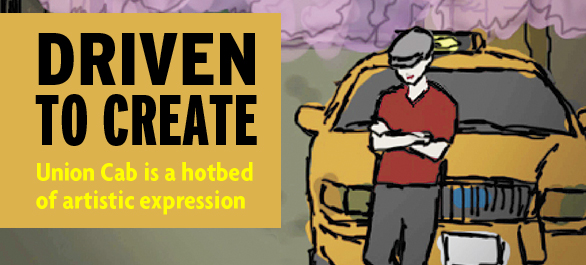
Jazz is playing, the sky is dark, and a bright yellow taxi pulls up outside Parthenon Gyros on State Street. “Y’know, I don’t know much about politics. All I know is that we just need a good, hard rain to wash the scum off the streets,” says the man behind the wheel.
It’s not the beginning of Taxi Driver. The man uttering those words isn’t Robert De Niro. He’s Fred Schepartz, local writer by day and driver with Union Cab of Madison Cooperative by night. And the scene is from “You Talkin’ to Me?” — Commie Taxi Drivers in Wisconsin, a DVD extra for Michael Moore’s latest film, Capitalism: A Love Story.
While Commie Taxi Drivers sprang from Moore’s imagination, there’s plenty of creativity inside those yellow cabs. Schepartz is a great example. When he’s not writing books, such as his 2007 novel Vampire Cabbie, he’s taking photographs and editing Mobius, a journal dedicated to literature, poetry and social change.
Without Union, this trifecta of creative output might not be possible. It’s hard to survive as a novelist if you’ve never published a book, and this was Schepartz’s situation for two decades. To pay the rent after college, Schepartz tried secretarial work and furniture sales, only to find himself with a pink slip — not a book deal — a few years later.
Then he heard about Union, a local, worker-owned cooperative brimming with artists, musicians and writers. Twenty-two years and several novels later, he’s still driving for Union. Like many fellow drivers, he’s discovered that you don’t need an MFA degree to make art, and that creativity and cab driving go hand in hand.
Of course, this combination doesn’t work for everyone. Cab driving in Madison requires a high tolerance for drunk people and the ability to stay cool when other drivers are texting and tailgating on the Beltline.
Plus, not every cab company offers a structure or vision like Union’s. Its mission statement includes a commitment to paying workers a living wage, whether they drive cabs, crunch numbers or clean toilets. For drivers, pay is based on a commission that’s a percentage of customer fees. The more hours drivers log, the bigger cut they get.
“Over the last 30 years or so, median wages for most working Americans have dropped, but the way Union Cab is set up, your real wage actually increases. And this helps the artistic life if you don’t have to work 60, 80 or 100 hours a week just to eke out a living,” Schepartz says. “And when you leave your shift, you don’t take your work home with you. To make art, you need a lot of time to think.”
Culture club
For Union Cab drivers, contemplation can even happen on the job, while waiting at an airport or a stoplight. For Mark Adkins, leader of Subvocal, a psych-folk band formed at Union Cab, an epiphany at the corner of State and Gilman streets led to one of his most memorable songs, “11303.”
“I saw this student walking by who was very pretty, except her nose was missing. I wondered how she dealt with her lot in life, and I began thinking about how people wear these different masks,” he recalls. “I came up with the song’s first line, ‘I see nothing but sorrow walking down the street,’ and I realized I was writing down feelings about my brother, who’d recently committed suicide. It was a real turning point.”
The album containing “11303,” Nikkis Room, was a turning point as well, winning Subvocal the 2005 Madison Area Music Award for best CD.
Good pay and ample downtime aren’t the only reasons creative people flock to Union. The co-op takes pride in its nontraditional philosophy about work. As a result, its culture isn’t typical.
“People are exactly who they say they are there, and it’s a very comfortable place to work because you don’t have to worry about what other people think,” says Jai Ingersoll, Union alum and vocalist for local goth-tronica group Sensuous Enemy. “I have tattoos and piercings and red hair, but it didn’t matter there. A lot of other places it would.”
Plus, if you talk to Union drivers at length, you’re likely to hear them refer to fellow worker-owners as family, not coworkers. As Adkins puts it, “We’re all writers and musicians and politicos, rebels and radicals and misfits. But even those of us with crappy attitudes will still get out of the car to fix your flat on a snowy day.”
This isn’t because Union workers are more compassionate than others; it’s a function of an environment that eschews competition and promotes empowerment, Adkins says. This type of atmosphere can also help talented people truly pursue their gifts, whether it’s music, metalworking or mime.
John McNamara, the co-op’s marketing manager, says a humane work environment simply encourages people to do their very best, whether it’s in the office, in a cab or at their after-work pursuits.
“We want people to like coming to work, not feel chewed up and spit out, which is the case at many companies. And because of the camaraderie that exists here, there’s a natural tendency to share and collaborate,” he says. “We work on teams and solve problems together. There’s not a lot of selfishness here, and that way of doing things spills over into other parts of people’s lives.”
McNamara credits much of this outlook to the zeitgeist of the 1970s, when Madison flexed its creative muscles in unprecedented ways. “People were really questioning the status quo and coming up with positive ways of changing the world,” he says. “The Union Cab people were part of this, along with WORT, the Willy Street Co-op, the Mifflin Street Co-op and Commonwealth Development.”
Problems plaguing the cab industry were troubling for drivers and consumers alike, he adds.
“Everything was being done on the cheap back then. Vehicles were unsafe, and drivers were very poorly paid. That translated into poor morale and poor customer service.” And that’s one thing Union’s founders set out to change.
Creative folks soon caught wind of the co-op’s flexible schedules, which could easily accommodate a band’s cross-country tour or a two-month writing sabbatical, and began to fill the Union’s ranks. Pretty soon, Butch Vig, who would go on to found Smart Studios and the band Garbage, was driving a Union cab. So was Michael Feldman, who now hosts the comedy and quiz show Whad’Ya Know?, which is heard on public radio stations across the country. Local author and historian Stu Levitan and Latin-jazz icon Tony Castañeda followed, along with many others.
Feldman, who drove for Union from 1981 to 1983, after quitting his first radio show, says unemployment led him to the co-op, along with its reputation for hiring creative individuals.
“They were hiring people like actor cab drivers and writer cab drivers, and they took me because I was a minor celebrity. They thought it would be good for business, but I was a terrible cab driver.”
Though Feldman doubted his cabbie skills, the gig led to something useful: a new public radio show. “We taped radio bits in the cabs and called it The Dispatcher,” he says. As a dispatcher wrangled cabs, “I’d be trying to break in with a question, like ‘What caused the extinction of the dinosaurs?’ We’d tape that and put it on the air.”
Rearview visionaries
Since Union has more than 200 employees, chances are good that an artsy new hire will already know a few other workers from gallery night or the local concert scene. Once these folks find each other, collaboration ensues.
Take longtime cabbie Kelly Burns Gray. A visual artist, she made sure a new CD of music by Union employees past and present came to be. Some of this do-good spirit stems from her personality, but another motivation is thanking Castañeda, who mentored her on some of her first drives.
“One of the things he trained me on was how to hold a coffee cup between my legs and use my lap as a plate. That experience sealed the deal,” she recalls.
Gray had watched Adkins put together Rearview Visionaries, a disc of Union cabbies’ original music, in 2002, so she knew the project could be done if she connected with the right people. With songs by Model Citizen, Wayside, Subvocal and others, the album’s still talked about among cabbies, and many seemed eager to create a follow-up. According to Steve Pingry, cellist for Subvocal and the Getaway Drivers, the original idea was to create a Rearview Visionaries boxed set, so a second CD would mean that the project was two-thirds complete.
After soliciting submissions on Facebook and through the grapevine, Gray got in touch with local musician and fellow cabbie Lonnie Wild, who paid for duplication of the new CD. Meanwhile, Smart Studios’ Mike Zirkel volunteered to master it. The final product debuted in January, featuring tracks by Sensuous Enemy, the Stellanovas, the Getaway Drivers, Castañeda and many others. In addition to spinning in many cabbies’ cars, it won a Madison Area Music Award this spring.
Meanwhile, Kristin Forde, a visual artist, theater person and Union cabbie of six years, has been organizing art shows with a purpose similar to the CDs’: to highlight the co-op’s creative talent. The first show, featuring political posters, photography, blown-glass mixed-media pieces and more by 10 Union Cab artists, took place last summer at the Gallery at Yahara Bay Distillery. Another will take place at the gallery July 29 through Sept. 24 of this year, with an opening reception July 30.
Forde, a former middle school teacher, credits cab driving for sparking a personal artistic awakening, so organizing a show is the least she can do to give back.
“Cab driving has opened up my creative life tremendously,” she says. “There’s something about being in constant motion, with the scenery always changing, that’s important to the photographs I take.”
And this sense of moving forward, making progress toward destinations physical, political, psychological and spiritual, is crucial to what Union stands for. It’s only natural that cabbies show off the values they’ve taught and learned at the co-op.
“The co-op model attracts people who are interested in an alternative way of life, one that’s very participatory and has a strong creative element,” Forde says. “Those of us who work at Union own it, too, so it’s up to us to make sure it remains this unique place that nurtures things the greater society doesn’t always value: individuality, creative expression and, of course, union.”
With gargantuan, Steve Urkel-style glasses and an obsession with the bleeps and bloops of computers, Dan Deacon could be the second coming of Revenge of the Nerds’ violin-toting Arnold Poindexter.
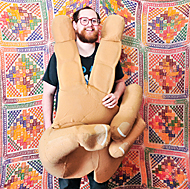
Deacon, 27, grew up in the midst of the Long Island ska explosion, performing songs like “Bionic Man Hands” with his band Channel 59. He then went to the local art-nerd institution of choice, SUNY Purchase, to study computer music composition and electro-acoustic instruments. Though Deacon mastered a number of traditional instruments, from guitar to tuba (which he’s played with fellow Purchase alum Langhorne Slim), he chose to record collages of random sounds and sine waves from a Wavetek 180 signal generator.
While his early efforts were more sound art than popular song, Deacon found a fan-friendly formula in his 2007 album Spiderman of the Rings. He mixed goofy-yet-nostalgic lyrics such as “My dad is the coolest dad in dad school / He does not break any dad-rules” with layers of melody that recall Philip Glass. His brand-new album, Bromst, has pleased critics and fans alike, showcasing both his sense of humor and collages of samples that are a bit more grown-up, like a mind-bending round made from a Native American chant.
However, it’s Deacon’s live performances that have made him a household name — if your house is anywhere near an art school or a hipster enclave — by getting disaffected-looking concertgoers to smile genuinely, spill Coke on their vintage pants and abandon their posturing for an entire evening.
How? Deacon’s personality has a lot to do with it. Hooking himself up to a grid of musical machines, he plants himself in the audience and leads fans on a trip that’s as much a spiritual journey as it is a return to grade-school recess. At his Forward Music Fest performance last fall, Deacon invited concertgoers to take part in a Grease-style dance-off to a soundtrack of his tunes. Then the lights went out, Deacon’s LEDs began to blink, and the crowd became a writhing amoeba of sweaty fans simultaneously shouting out lyrics and immersed in their own imaginations. It was as close to a rave as one can get these days, but something else as well.
Viewed from afar — or from above at the Majestic, where he performs May 4 — the scene is performance art, with the audience unaware of its role as performer. That’s the kind of engineering that someone who’s both a math nerd and an art dork could achieve.
John Davis’ sophomore release as Title Tracks proves he’s a force to be reckoned with in the crowded field of power-pop. The former member of post-hardcore outfit Q and Not U recruited a band for this disc, dressing his punkish troubadour tunes in rhythmic guitars and fast-paced drums.
Davis uses Elvis Costello’s vocals as a model throughout the album, infusing them with Ted Leo’s vigor. Opening track “Shaking Hands” takes a Ramones-meets-Rubinoos approach to popcraft, punctuated by the occasional shouted vocal but driven by solid hooks. Adrenaline flows as guitars race and drums thunder, leading into a fist-pumping second track, “Turn Your Face.” The melody’s simple enough for sing-along moments but rarely gets boring, soaring when you expect it to dive and exploring minor-key moments when a ray of sunshine seems just around the corner.
“I Can’t Hide” warms up with fuzzy guitars, then finds a kernel of joy in its rich, major-key chords. Meanwhile, the guitars take on a Velvet Underground-style timbre, hinting at a sped-up “I’ll Be Your Mirror.” However, the penultimate tune, “It’s Wrong,” is where things really get interesting, with a Shins-style nod to the Honeycombs’ 1964 hit “Have I the Right.”
When you’re barreling down East Washington Avenue, it’s easy to speed past the brick building on the northwest corner of Baldwin Street. There are no signs, few parked cars and a handful of boarded-up windows. It seems ripe for a haunting, not a historic happening.
But that building, the legendary Smart Studios, is one of the liveliest places in town. It has been for more than 25 years, even when it was just two guys, an eight-track tape recorder and a tiny collection of microphones. Over the years, Smart was a rock ‘n’ roll refuge for more than 1,000 bands who recorded there.
The studio just announced that it will close its doors this spring amid a dramatic downturn in the music industry. The tentative closing date is March 1.
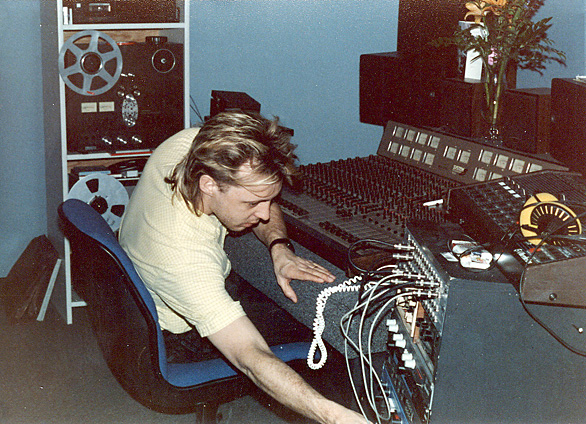
Smart Studios got started on the south side of East Wash in 1983, when Butch Vig and Steve Marker moved their gear into a dusty old factory space. It was a step up from recording on a four-track in Marker’s basement, which they’d been doing since their student days at UW-Madison.
“We started Smart because we wanted a place to hang out and make music, like a clubhouse,” Vig explains. “I’ve always looked at it as a sanctuary.”
Although the studio is closing, Vig says there’s cause for celebration.
“We rocked Smart for 25 years, and we rocked Madison, too,” he says. “Two-thirds of our client list was local and regional bands, and Steve and [chief engineer] Mike [Zirkel] and I are probably even prouder of those projects than the [Smashing] Pumpkins and Sparklehorse and Freedy Johnston. We tried to help as many local bands and labels as we could.”
Gimme shelter
Early on, helping the local music scene meant recording punk bands on the eight-track for five bucks an hour, when Milwaukee and Chicago studios told Vig and Marker to charge 20 times more. Ironically, inexpensive recording technology is now driving musicians away from professional studios and back into their basements.
“You can look at the closing of Smart as a direct reflection of what’s been happening in the music business and the technology changes that have happened over the last 10 years,” says Vig. “Now anyone can get a laptop and make recordings in their basement for next to nothing. I know Grammy-winning engineers in L.A. who are struggling to find work.”
Plus, the labels that normally would pay for studio time have slashed their budgets to half or a third of their usual size, Vig says. It seemed like the right time to throw in the towel.
“We were never in this to make money,” he says. “In fact, it’s a miracle that Smart stayed open as long as it did considering it was run by two guys with almost no business sense.”
For Vig and Marker, treating other musicians like family, whether they were from Sun Prairie or Sunset Boulevard, was the key to their happiness and success.
Isaac Schulze, singer/guitarist for local cowpunk trio Mad Trucker Gone Mad, says being able to barbecue a turkey on Smart’s deck and play videogames at the studios made him feel at home — and perhaps led to a better record.
Meanwhile, Keith Brammer, bassist for Milwaukee hardcore and alt-rock torchbearers Die Kreuzen, recalls Smart as a place that didn’t cop a ‘tude, no matter what.
“You were never made to feel like a second-class citizen if you weren’t on Warner Brothers, and there was none of the ‘You gotta get out of here because such-and-so is coming in’ crap,” he says. “It was ‘You’re here, that’s what matters, and we’re gonna take care of you.’ You always felt comfortable there, and you knew those guys were in it for the right reasons.”
Smart’s all-in-the-family approach also meant working with local bands’ budgets. Eric Hartz, drummer for Hum Machine, a local alt-rock band whose album The Trance Voltage Solution ruled college radio in the late 1990s, remembers just how far the Smart staff could stretch a dollar.
“You got this really high-quality recording service and access to a lot of expensive equipment most people never even get a chance to use. And besides the recording, you got access to this great network of people who would share tips, including some pretty big-name musicians. Those people aren’t going to be coming around now that Smart is closing.”
Naked singers
It was the combination of comfy and crazy that drew many famous artists to Smart.
Members of L7, the all-girl grunge-and-punk band that paved the way for the riot grrrl movement, loved Smart for its geeky charm and the giant tubs of ice cream it supplied. They also loved the superb sound of Bricks Are Heavy, the album Vig produced during their 1991 Madison visit, shortly after working on Nirvana’s Nevermind.
Singer/guitarist Donita Sparks laughs when she recalls meeting Smart’s engineers. “At first I thought the guys were a little shy or terrified of us, one of the two. They’d be polite and say hello but not make a lot of eye contact.”
The Smart staff got over their dorky crushes before the end of L7’s studio sessions, but Vig kicked his geek factor up a notch when a local TV show decided to stop by. Though the band members were taking a breather amid 12 hours of recording, they decided to make it look like they were blowing the place to smithereens.
“We staged a little scene,” says Sparks. “Butch was at the board looking very serious, and [singer/guitarist] Suzi [Gardner] and I were behind the microphone. I smeared makeup all over my face like I’d just had a nervous breakdown. We looked like complete terrors; it was hilarious.”
Engineer Beau Sorenson says there are plenty of other stories where this one came from, especially tales about naked people.
“One time, the lead singer of this band called Kilroy was having trouble hitting one of his notes,” he recalls. “We convinced him that the only way he was going to hit this note was by stripping down to nothing. It had worked for other people, so we figured it might work for him, too.”
Then there was Bernie Worrell of Parliament-Funkadelic, who’d stopped by to record some keyboard licks for Monday Night Football.
“He wore these purple velvet gloves, and when he took them off, he’d blow on his hands and say, ‘C’mon babies, don’t let me down!’ He was far out,” Sorenson recalls.
Vig also recalls moments of pure nuttiness. Once, he found engineer Doug Olson staring maniacally at 200 pieces of tape he’d recorded in a single session. Another time, he had to explain to the Edgewater’s manager how Kansas rockers Paw had destroyed the walls of their hotel room in a BB-shooting contest.
But Michael Gerald, singer and bassist for local noise-rock legends Killdozer, may have the best story of all. In the early days, the band would try to replicate sounds such as guns firing and heads being bashed with baseball bats. For their first album, 1984’s Intellectuals Are the Shoeshine Boys of the Ruling Elite, they set off firecrackers inside a walk-in safe at the original Smart site.
“It sounded too wimpy when we blew it up in the hallway, so Butch and Steve were like, ‘Well, how ’bout that safe in the basement?’ There had been a great amount of drinking involved, so we couldn’t be talked out of it. It was completely stupid and completely fun.”
Improvised genius
Many times, bands simply arrived at Smart with an idea, then came up with the rest off the cuff. Killdozer made at least two of their albums this way, says Gerald.
“There was one album, [1988’s] For Ladies Only, where we only knew we wanted to do cover songs, not even what the songs would be,” he recalls. “We were eager to have input from Butch and Steve, who’d do things like say ‘You know, this would be good with an accordion’ or call up their friends. Whoever answered the phone would come in and help out with the chorus, which is what we did in our version of ‘American Pie.'”
Another time, Vig called up Madison string players Chris Wagoner and Mary Gaines to sit in with a then-unknown band called Smashing Pumpkins. So as Smart brought national and international recording artists to Madison, it also introduced Madison musicians to the world.
This was especially true when Vig and Marker’s band Garbage hit the big time in 1995, after joining forces with Scottish vocalist Shirley Manson. There was a period when Rolling Stone followed the band around town, speculating that Madison would be the site of the next musical revolution.
Zirkel, who started at the studio around the time Garbage formed, remembers when Manson came to town to audition. When the iconic singer took up residence here, the city seemed poised for a glamorous makeover.
While Madison didn’t morph into a flashy, star-studded metropolis, Smart’s influence continued to grow in ways never anticipated. Sometimes the musicians who recorded there took home more than a great album. New Yorker Freedy Johnston adopted Madison as his second hometown in 1994 as he recorded his pensive power-pop album This Perfect World here.
Pretty soon Johnston found himself returning to Madison every few months to lay down tracks and play in Vig’s cover band the Know-It-All Boyfriends. He was even at Smart last week when news of the studio’s closing broke.
“Smart reminds me of my first days living here, when I hung out at Genna’s and got to know the friends I’m still hanging out with 15 years later,” Johnston says.
When the studio closes, those who’ve passed through Smart’s doors will also hang onto the stories behind their songs like old friends.
The Madison sound
A selection of albums recorded, or mixed, or both at Smart Studios
Tar Babies: Honey Bubble (1989)
Killdozer: Twelve Point Buck (1989)
Nirvana: Nevermind (1990)
King Snake Roost: Ground Into the Dirt (1990)
Laughing Hyenas: Life of Crime (1990)
Smashing Pumpkins: Gish (1991)
The Young Fresh Fellows: Electric Bird Digest (1991)
L7: Bricks Are Heavy (1992)
Freedy Johnston: This Perfect World (1994)
Everclear: Sparkle and Fade (1994)
Soul Asylum: Let Your Dim Light Shine (1995)
Garbage: Garbage (1995)
The Promise Ring: 30° Everywhere (1996)
Fall Out Boy: Take This to Your Grave (2003)
Death Cab for Cutie: Plans (2005)
Sparklehorse: Dreamt for Light Years in the Belly of a Mountain (2006)
Jimmy Eat World: Chase This Light (2007)
Hotel Lights: Firecracker People (2007)
Chief engineer Mike Zirkel encourages those with photos,
video and other memories of Smart Studios to share them via a Facebook group
called the Smart Studios Appreciation Society, and Vig may green-light a
documentary project later this year. Stay tuned to Isthmus and TheDailyPage.com
for details.